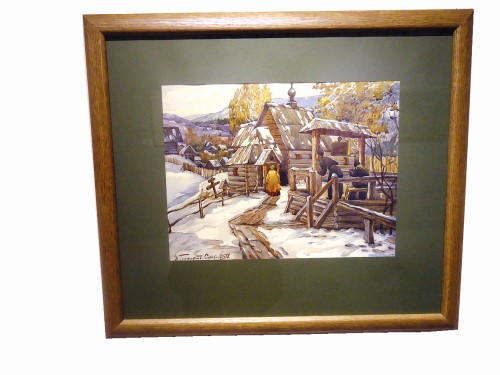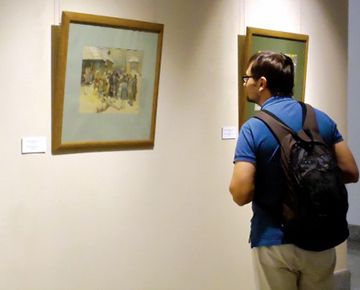
The exhibition gathers artworks from the National Art Museum of Belarus, featuring over 30 pieces by 20 artists. Watercolours are widely held to be no less emotionally expressive than oil paintings, having their own fragility and ethereality, as well as depth of light and colour; they have their own charm and require both technique and flair. Accuracy is important, since corrections in the course of work are almost impossible, for fear of losing freshness, and colour transparency.

Much to see at the exhibition
The last two decades of the 19th century and the beginning of the 20th century were a time of great interest in watercolours by Russian painters, who would use the medium for preparatory sketches for future canvases and theatrical set designs. The Society of Russian Watercolour Painters launched, and there were numerous watercolour exhibitions, displaying pieces by masters in various creative trends. This, undoubtedly, stimulated Russian artists’ interest in watercolour techniques.
Almost all painters work with watercolours, yet without stylistic unity or uniformity of technique, each having their own preferences. The use of ‘pure’ watercolours is rare, since most apply a mixture of mediums: watercolour, gouache, pastels and charcoal.

Ivan Goryushkin-Sorokopudov Skete (1910)
The Pastels and Watercolours by Russian Painters from the Second Half of the 19th Century exhibition familiarises us with watercolour painting from Russia, showing the main trends and characteristics from this period, and demonstrating their emotional expressiveness. Works by 20 artists are on show, some more famous than others, but each with their own manner, world outlook, and technique, depending of their task.
Larger works by Vasily Surikov, Isaac Levitan and Alexandre Benois are on show: Surikov’s Pompeii. Dorian Columns (1884) uses transparent glaze, in his favourite tones of delicate blue-grey. Meanwhile, we see the softly overflowing musicality of nature’s moods in Levitan’s work. Benois’ Versailles. At Curtius, his Peterhof. Golden Mountain, and his Peterhof. Hermitage, focus on architectural motifs, giving a real feel of the age. Each work uses graphic detail but is modern in atmosphere, with classical use of colour and the addition of whiting ceruse.

Boris Kustodiev’s Meeting at the Corner (1920)
Albert Benois only worked in ‘pure’ watercolours or a mixed technique, creating such landscapes as Summer Evening and Finland. View from the Balcony. He used wide, free strokes and complex colour solutions, shifting from one tone to another and using the colour of his paper to create a feeling of light and air, as in the open spaces of nature.
Apollinary Vasnetsov is known for his historical works, such as Torzhok (1930) and Moscow. Voskresensky Bridge in the 18th Century (1917). He used a mixed technique, in which colour never played a leading role. Rather, the graphics dominate the compositional structure and space.

Apollinary Vasnetsov’s Veche in
Pereyaslavl-Yuzhny, 12 Century (1908-1909)
Being a great age for the theatre, this found its response in the creativity of painters. Watercolours were used to decorate theatre sets and to adorn costumes. Veche in the Moscow Kremlin (1901) is a sketch of the set used for Nikolai Rimsky-Korsakov’s Pskovityanka opera, created by one of Russia’s leading theatrical artists Alexander Golovin.
By Veniamin Mikheev











